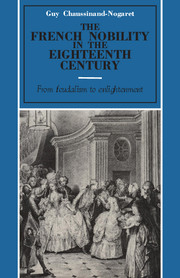Book contents
- Frontmatter
- Contents
- Introduction: the gilded ghetto of royal nobility
- 1 The Enlightenment and noble ideology
- 2 The nobility between myth and history
- 3 Plutocrats and paupers
- 4 The fundamental divide: culture
- 5 The nobility and capitalism
- 6 Rites and strategies: the marriage market
- 7 The nobility against the Old Regime
- 8 A plan for society
- Conclusion
- Afterword to the English edition
- Notes
- Bibliography
- Supplementary bibliography
- Index
Introduction: the gilded ghetto of royal nobility
Published online by Cambridge University Press: 05 June 2012
- Frontmatter
- Contents
- Introduction: the gilded ghetto of royal nobility
- 1 The Enlightenment and noble ideology
- 2 The nobility between myth and history
- 3 Plutocrats and paupers
- 4 The fundamental divide: culture
- 5 The nobility and capitalism
- 6 Rites and strategies: the marriage market
- 7 The nobility against the Old Regime
- 8 A plan for society
- Conclusion
- Afterword to the English edition
- Notes
- Bibliography
- Supplementary bibliography
- Index
Summary
May 1789. The Estates-General met at Versailles. The three orders processed ceremonially. The second order, the nobility, shone with all the brilliance of gold-embroidered coats and capes, white-plumed hats, and engraved ceremonial swords. Alongside the nobility the third estate was dark and sombre, a sorry sight. Yet: brilliant as it still appeared, still today at the head of the procession, the nobility could already feel the cold wind of defeat.
It had become, by imperceptible stages which had mostly escaped its notice, a marginal minority in French society, under sentence. In 1789 nobles were the kingdom's Jews.
To be sure, the nobility still exercised an irresistible attraction, and for broad areas of opinion it was the only model. Its code of honour, its ritual refined from the politeness born of court ceremonies, its style, behaviour and way of life, were still dominant. Nobility remained the supreme ambition of the unrepentantly elitist middle classes, who saw in ennoblement a way of escaping the confusions which ranked them with the most despised elements of a third estate with which fundamentally they felt so little in common. But, at the same time as it engendered social imitation, the nobility aroused envy and indeed hostility, mingled with feelings of frustration and anxiety in the face of a group ill-understood, perceived as alien, and easily enough as antagonistic. This sharp awareness of difference, no doubt stronger among non-nobles than nobles themselves, could and indeed soon did give rise to delusions which the ‘aristocratic plots’ of the Revolution would bring to the surface.
- Type
- Chapter
- Information
- The French Nobility in the Eighteenth CenturyFrom Feudalism to Enlightenment, pp. 1 - 10Publisher: Cambridge University PressPrint publication year: 1985



